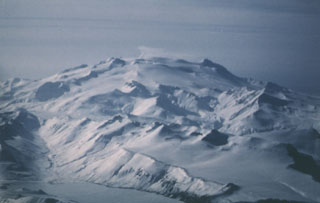Report on Makushin (United States) — 10 June-16 June 2020
Smithsonian Institution / US Geological Survey
Weekly Volcanic Activity Report, 10 June-16 June 2020
Managing Editor: Sally Sennert.
Please cite this report as:
Global Volcanism Program, 2020. Report on Makushin (United States) (Sennert, S, ed.). Weekly Volcanic Activity Report, 10 June-16 June 2020. Smithsonian Institution and US Geological Survey.
Makushin
United States
53.891°N, 166.923°W; summit elev. 1800 m
All times are local (unless otherwise noted)
AVO reported that over a period of several hours on 15 June there were two earthquakes in the vicinity of Makushin that were greater than M 4 and one greater than M 3. The events were located about 11 km SE of the summit at a depth of about 8 km, and felt in Unalaska (14 km E). Numerous smaller earthquakes were recorded, though not felt by Unalaska residents. AVO noted that the earthquakes represented a departure from background levels and were possibly indicative of volcanic unrest; the Aviation Color Code and Volcano Alert Level were respectively raised to Yellow and Advisory. The report noted that aftershocks were continuing.
Geological Summary. The ice-covered Makushin volcano on northern Unalaska Island is capped by a 2.5 km caldera. Its broad, dome-like structure contrasts with the steep-sided profiles of most other Aleutian stratovolcanoes. Much of the edifice was formed during the Pleistocene, but the caldera (which formed about 8,000 years ago), Sugarloaf cone on the ENE flank, and a cluster of about a dozen explosion pits and cinder cones at Point Kadin on the WNW flank, are of Holocene age. A broad band of NE-SW-trending vents cuts across the volcano. The composite Pakushin cone, with multiple summit craters, lies 8 km SW. Table Top (Pleistocene, 68 +/- 14 ka) and Wide Bay (Holocene) cinder cones are about 20 km ENE on the peninsula across the bay from the City of Unalaska. Frequent explosive eruptions have occurred during the past 4,000 years, sometimes accompanied by pyroclastic flows and surges. Geothermal areas are found in the summit caldera and on the SE and E flanks. Small-to-moderate explosive eruptions have been recorded since 1786.
Source: US Geological Survey Alaska Volcano Observatory (AVO)

